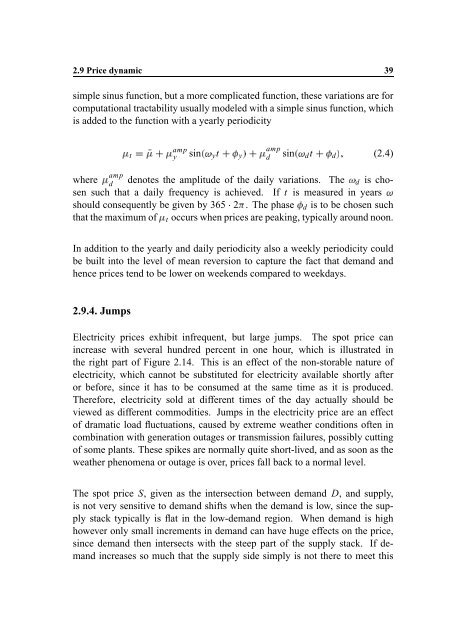Hedging Strategy and Electricity Contract Engineering - IFOR
Hedging Strategy and Electricity Contract Engineering - IFOR
Hedging Strategy and Electricity Contract Engineering - IFOR
You also want an ePaper? Increase the reach of your titles
YUMPU automatically turns print PDFs into web optimized ePapers that Google loves.
2.9 Price dynamic 39<br />
simple sinus function, but a more complicated function, these variations are for<br />
computational tractability usually modeled with a simple sinus function, which<br />
is added to the function with a yearly periodicity<br />
Q t Q Q<br />
amp<br />
y sinSXT yt U yV Q<br />
amp<br />
d<br />
sinSXT dt U dV?G (2.4)<br />
amp<br />
Q where<br />
d<br />
denotes the amplitude of the daily variations. T The d is chosen<br />
such that a daily frequency is achieved. If t is measured in T years<br />
should consequently be given by 2W 365 . The U phase d is to be chosen such<br />
that the maximum Q of t occurs when prices are peaking, typically around noon.<br />
In addition to the yearly <strong>and</strong> daily periodicity also a weekly periodicity could<br />
be built into the level of mean reversion to capture the fact that dem<strong>and</strong> <strong>and</strong><br />
hence prices tend to be lower on weekends compared to weekdays.<br />
2.9.4. Jumps<br />
<strong>Electricity</strong> prices exhibit infrequent, but large jumps. The spot price can<br />
increase with several hundred percent in one hour, which is illustrated in<br />
the right part of Figure 2.14. This is an effect of the non-storable nature of<br />
electricity, which cannot be substituted for electricity available shortly after<br />
or before, since it has to be consumed at the same time as it is produced.<br />
Therefore, electricity sold at different times of the day actually should be<br />
viewed as different commodities. Jumps in the electricity price are an effect<br />
of dramatic load fluctuations, caused by extreme weather conditions often in<br />
combination with generation outages or transmission failures, possibly cutting<br />
of some plants. These spikes are normally quite short-lived, <strong>and</strong> as soon as the<br />
weather phenomena or outage is over, prices fall back to a normal level.<br />
The spot price S, given as the intersection between dem<strong>and</strong> D, <strong>and</strong> supply,<br />
is not very sensitive to dem<strong>and</strong> shifts when the dem<strong>and</strong> is low, since the supply<br />
stack typically is flat in the low-dem<strong>and</strong> region. When dem<strong>and</strong> is high<br />
however only small increments in dem<strong>and</strong> can have huge effects on the price,<br />
since dem<strong>and</strong> then intersects with the steep part of the supply stack. If dem<strong>and</strong><br />
increases so much that the supply side simply is not there to meet this
















